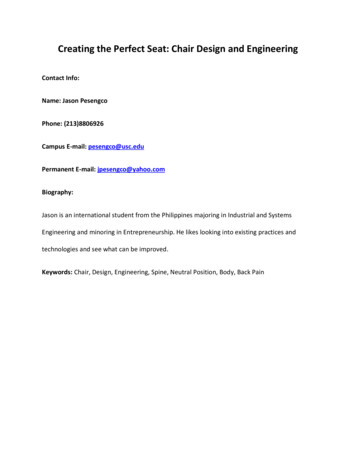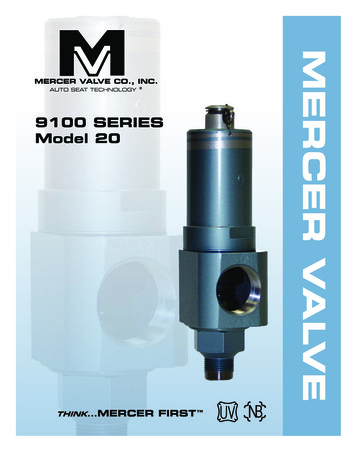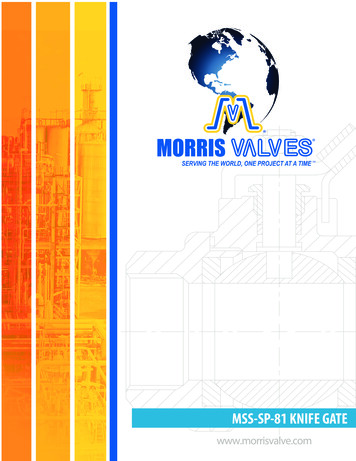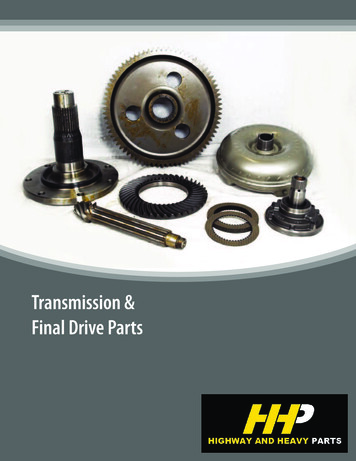
Transcription
Creating the Perfect Seat: Chair Design and EngineeringContact Info:Name: Jason PesengcoPhone: (213)8806926Campus E-mail: pesengco@usc.eduPermanent E-mail: jpesengco@yahoo.comBiography:Jason is an international student from the Philippines majoring in Industrial and SystemsEngineering and minoring in Entrepreneurship. He likes looking into existing practices andtechnologies and see what can be improved.Keywords: Chair, Design, Engineering, Spine, Neutral Position, Body, Back Pain
AbstractThe human body was never meant to live a sedentary lifestyle. Yet, many people todayspend most of their time sitting in front of their desks and computers on poorly engineeredchairs. In the long run, this can lead to grave problems such as lower back pain, poor bloodcirculation, low energy levels, stressed joints and misaligned spines. Aside from this, thesechairs can also cause the negative permanent restructuring of the body – the body will becomestuck in an “unnatural position.” Therefore, it is vital that this serious problem be alleviated.And, although it is ultimately the responsibility of people to assume correct posture whensitting down, a well-engineered chair can certainly help out and promote the proper posture.As such, this article aims to explain and explore the engineering, technology, and feasibilitybehind the possibilities of creating a perfect chair and putting an end to problems associatedwith ill-engineered chairs.
Creating the Perfect ChairIntroductionAccording to the British Chiropractic Association, the human body was never made forsitting down [1]. However, modern society dictates otherwise. With the majority of peoplespending most of their days sitting on poorly engineered chairs in offices and schools, a numberof unfavorable conditions have arisen: chronic lower back pain, poor blood circulation,unnatural posture, low energy levels, and stressed joints.This is a serious issue because the act of sitting for prolonged periods severely injuresand wears down the human body over the long run. According to the British ChiropracticAssociation, the human body is not “designed to be so sedentary [1].” Instead, it was built foran active lifestyle, constantly hunting and gathering food [1]. Nonetheless, times have changed;people have to sit down and work to earn a living. Still, there has got to be a solution that willalleviate this problem.Imagine a chair that allows your ankles to rest comfortably at the ideal angle, does notrestrict blood flow whatsoever, and fully supports your upper and lower back. In fact, thereality of having such a chair is closer than people might believe; modern chairs have come along way from their predecessors such as stone-made seats from the Roman Empire. Throughadvancements in engineering design and breakthrough technologies, the characteristics andfeatures of chairs will continue to improve, and ultimately be perfected. Still, a chair’sfunctional and raw design should be based on the ergonomics of sitting.
The Art of SittingThe ergonomics of sitting revolves around the physiology and structure of the humanspine. The human spine is also known as the spinal or vertebral column, or in simple terms the“backbone” [2]. This aspect of the central nervous system is responsible for providing thehuman body with a flexible central support system [2]. It embodies 33 ring-like bones called thevertebrae which are wrapped with strong ligaments and muscles [2]. In essence, the spine holdsthe head and torso upright, yet enables the back and neck to bend and twist [2]. The waypeople sit and what they sit on strongly affects the health of their spines. Essentially, there arethree types of sitting positions: anterior (forward leaning), middle (relaxed, unsupported), andposterior (backward leaning) – the first and the last being more ideal [4].Biomechanics of SittingAccording to the Musculoskeletal Association of Chartered Physiotherapists (UK),various sitting postures have different effects on spinal load and trunk muscle activation. Somepositions reduce the burden on the backbone [3]. Hence, a poor sitting posture which is mainlyassociated with the engineering design of the chair can cause spinal flexion, which negativelydistresses spinal proprioception (the unconscious perception of movement and spatialorientation arising from stimuli within the body itself) and ultimately leads to lower back painand restricted blood circulation. However, if the chair is already designed perfectly, it will be upto the people to correct their sitting positions – many experts recommended a slightly lordotic(curved inward) sitting posture which mimics the natural curve of the lumbar region of the
spine. As seen in Fig. 1, the Kyphosis sitting position (excessive outward curve of the spine/hunching of the back) is not ideal for the human body as it puts stress, taxing load, and unevenpressure on the discs. If people observe and assume poor postures consistently and repeatedlyover a long period of time, their bodies and spines will eventually adapt and restructurethemselves, resulting in abnormality, misalignment, and chronic pain.Fig.1 : Kyphosis Sitting Position [7]It is important for people to assume their roles in practicing correct posture. Still, manyof the ill-engineered chairs today make this a difficult task. This is because manufacturersprioritize profit margins over the expensive engineering and production that goes into makingthe ideal chair.Characteristics of the Ideal ChairImagine no back aches, neck pain, or lack of energy. According to industrial and systemsengineers, the human interface with the world of work strongly affects people’s physiologicalhealth [6]. For instance, a dimly lit office with uncomfortable chairs and unreasonably hot
temperature would contribute to a high rate of absenteeism. Thus, human factors (specificallyphysiological characteristics such as the curvature of the spine and build of the nervous system)play a large role in shaping the characteristics of the perfect chair [6].Ideally, a human-friendly chair would normalise spinal load and trunk muscle activation[3]. This would entail a comfortable and adjustable head rest allowing comfort and support forthe neck – this would alleviate stiff necks. Additionally, it would include a slightly curved inwardback support which will enable the spine to rest in its neutral position (i.e. spinal load and stressare minimized). Aside from this, the curved inward support unit will extend lung capacity,allowing deeper and more relaxed breathing as it forces the lungs and diaphragm to be at theupright position [8]. Further, it should feature an ergonomic recline system allowing the body torest between the angles 100-110 degrees, which will lessen the stress on the lumbar (back)muscles – the user will be able to alter from the anterior and posterior positions with relativecomfort and ease [4]. Moreover, it needs to have adjustable height; a high chair tends toincrease pressure at the popliteal fold (underside of the knees), increasing pressure on thenerve and restricting blood circulation, while a low chair tends to increase weight on the ischialtuberosities (bony swelling found on lower part of the back), causing back pain [4]. Seat depthand cushioning should also be adjustable. Ideally, 14-18.5" for seat depth, as this allows theuser to lie on the back rest, and 1.5-2" for cushioning as this enables the optimum comfort level[4]. To further promote proper posture, armrests should be installed as these provide extrapostural, sitting, and standing support; however, these should not engage the bony parts of theelbow where the sensitive ulnar nerve is close to the surface [4]. Finally, the chair should alsobe equipped with an elevated leg rest to promote unrestricted blood circulation through the
organs and the body – this can help revitalize energy levels. Sadly, these types of chairs areinaccessible to the wide public.In fact, Peter Opsvik, a Norwegian Industrial Engineer, became frustrated with theavailable chairs on the market that he decided to design one himself. As seen in Fig. 2, Opsvik’schair design includes most of the characteristics of an ideal chair. In Fig. 3, it can be observedthat a person is resting in the neutral position. Still, many chair manufacturers have ignoredthese human factor associated solutions.Fig. 2: Peter Opsvik’s Ideal Chair Design [9]Fig. 3: Person Resting in the Neutral Position [9]
Creating the Ideal Chair: The Engineering behind itCreating the ideal chair has a lot to do with engineering: manufacturing processes andmaterial selection.Fundamentally, the chair’s structure is determined by the characteristics of its materialand the manufacturing processes used to build it. Some manufacturing processes that are ableto produce chairs are plastic injection molding, metal casting, forming, stamping and shearing.These processes have their advantages and disadvantages [5].The plastic injection molding process involves filling (injecting) molten plastic into amold and then applying pressure to it to allow it to solidify to the desired shape. Usually,thermosetting plastic material is used for this process due to its nature of being consistent andirreversible after solidifying [5]. Aside from this, the plastic injection molding process allowsextremely complex shapes to be built. Hence, plastic molded chairs can have the propercurvature, bends, height, and angles. Thus, the injection molding process can be extremelyadvantageous as it allows the chair to accommodate the raw human physique (i.e. the slightcurvature of the spine) at relatively low cost. And due to its efficient, quick, and simple process,ideal chairs with high dimensional accuracy and stability can become accessible to the majorityof people [5].Likewise, the mentioned metal processes above can also build complexly engineeredand spine-friendly chairs. In fact, the metal processes would likely offer a more solid and stiffbuild, hence forcing people to sit in the proper position, offering greater postural support.However, these metal processes would drive up the costs of production and hence the retail
price of these ideal chairs, denying some people the ability to own one. As seen in Fig. 5, the“Perfect Chair” by Human Touch features a leather finish with an underlying electronic metalchassis. Although this chair may be ideal since it solves the problems associated with poorlyengineered chairs (such as lower back pain, neck pain, and limited blood circulation), it coststhousands of dollars; therefore, it is not accessible to a large market. However, a metal chairwould still be more ideal than a plastic chair since it provides enhanced adjustability, durability,and reliability [5].Fig. 5: “The Perfect Chair” by Human Touch [8]FeasibilityAlthough the technology of creating an ideal chair is already available, the costs ofproduction are extremely high (e.g. “The Perfect Chair” by Human Touch as seen in Fig. 5);hence, it is not accessible to majority of people because of the high retail price. Aside from this,there are few companies like Human Touch that diligently invest in producing a well-engineeredchair possibly because of relatively high cost and low demand. Besides this, these chairs can
further be improved if each of them were custom built and tailored to each individual user (i.e.specific leg, arm, and back measurements will be used to build the chair), yet again, addingmore costs. Without competition, which fuels innovation, specialized companies such asHuman Touch will be able to continue to sell at a premium price. Still, it is feasible that perfectlyengineered chairs will one day be ubiquitous in workplaces and schools universally –continuous ground breaking technology makes this possible.For example, 3D printing allows computer models of realistic objects to be printed in afew hours [5]. People would then be able to use 3D scanners to create an extremely accurateimage of their body proportions and hence, these photographs can be used to determine thedimensions of a custom-tailored chair, which can be printed out on the same day.The Future of Perfectly Engineered Chairs: The End of Lower Back PainThrough diligent research, constant innovation, and generous funding, the perfect chairwill one day be accessible to the mass population. But more significantly, according to Dr.Waseem Bashir of the Department of Radiology and Diagnostic Imaging at the University ofAlberta Hospital, “sitting in a sound anatomic position is essential, since the strain put on thespine and its associated ligaments over time can lead to pain, deformity and chronic illness [1].”In other terms, even though a perfect chair is developed, it is ultimately the responsibility of theuser to practice proper posture; the chair merely supports and promotes this correct posture.
References*1 BBC. (November, 2006). “Sitting straight bad for backs.” [2] S. Parker. (2009). The Human Body Book: An Illustrated Guide to its Structure, Function andDisorders. Spine (Book). Available: content/entry/dkbody/spine/0.[3] A. Moore. (2010, November). Manual Therapy. Journal [online]. Volume 15 (1). Pages 54-60.Available: nce/journal/1356689X/15/6.[4] Cornell University Ergonomics Web. “Sitting and Chair Design.” es/sitting.html.[5] S. Kalpakjian and S. Schmid, Manufacturing Engineering & Technology, 7 ed. , Prentice Hall,Apr. 11, 2013.[6] W. Turner, J. Mize, K. Case, and J. Nazemtz, Introduction To Industrial And SystemsEngineering, 3 ed. ,Prentice Hall, Aug. 30, 1992.*7 Statefund Caifornia. “Kyphosis Image.” atingConcepts11.gif[8] Human Touch. “Perfect Evolution of the Perfect Chair, Human Touch.” .html.*9 Arach Tchoupani. “Ideal Chair.” Available: res-the-best-programmers-chair-in-the.
tuberosities (bony swelling found on lower part of the back), causing back pain [4]. Seat depth and cushioning should also be adjustable. Ideally, 14-18.5" for seat depth, as this allows the user to lie on the back rest, and 1.5-2" for










